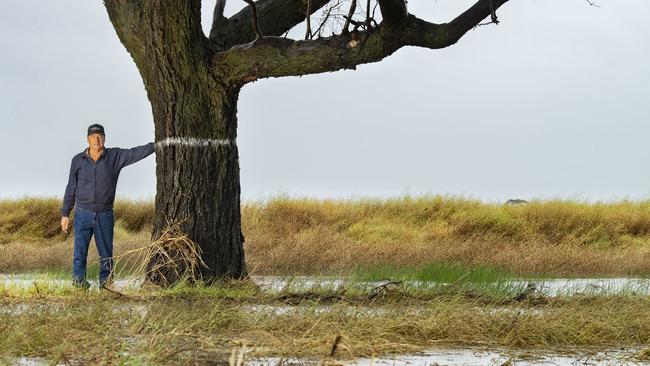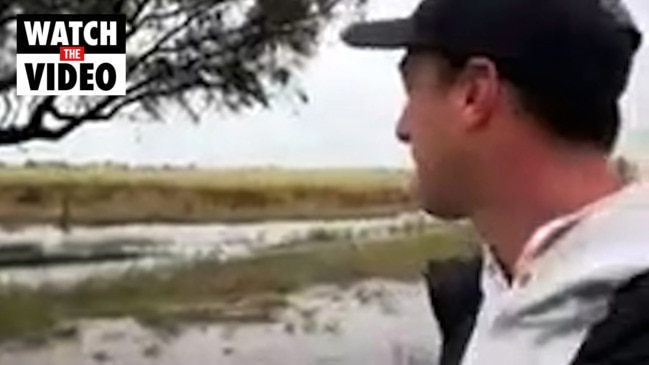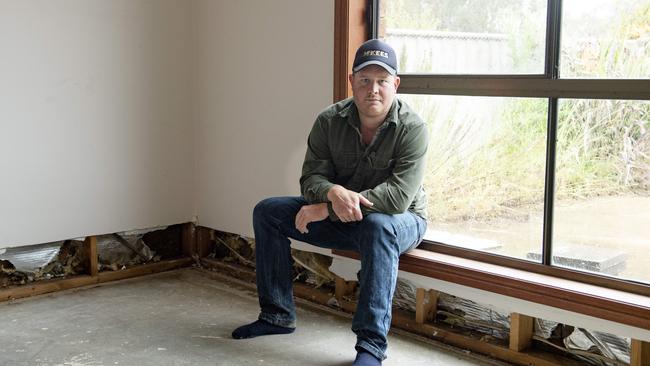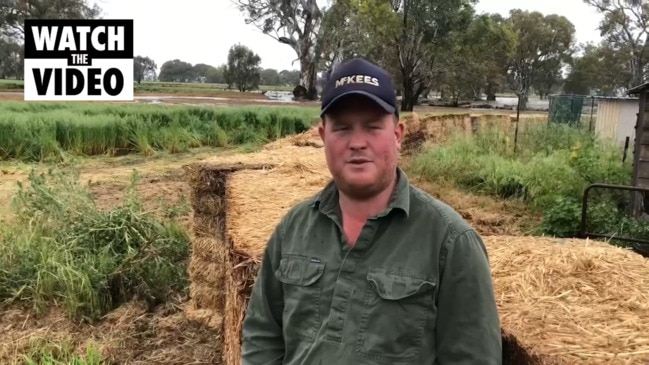Loddon Valley crops start to rot: Floods leave stench of heartbreak
Bountiful crops are collapsing and rotting in the wake of floodwater that still sits across most flood-ravaged farms. Hear the stories of three affected farmers.

The rot has set in across thousands of hectares of Loddon Valley crops, turning the best season in generations into the stench of heartbreak.
Patches of chest-high canola on the Parry family’s Powlett property have been flattened by floodwater, but the sour sulfurous smell streaming off the rest of the standing crop shows the rot is spreading.
“The loss (on the canola) alone is $1 million to $1.5 million,” Angus Parry said. “But we’re just one of many.”

Mr Parry and his father, Leigh, have marked a nearby tree at about 1.7m above the ground to show the peak of the flood that spilt out of the Loddon River 1.5km away and submerged their 480ha of canola.
Evidence of the river’s power can even be seen on the roadside, where carp rot far from their riverine home.
Back on the family’s home block it’s not the river that is killing their barley crop, but the steady flow of rainfall run-off that has spread out in vast sheets across the valley.
Leigh Parry and wife Helen have already started negotiations with their bank.
“They’re happy to defer interest on machinery and land we purchased a few years ago,” Ms Parry said.

The family is hopeful the rain will ease and they can salvage some of the canola and revive the lucerne on their river country and say their wheat crops are standing up well.
But the bitterest pill for the Parrys to swallow is the loss of the most costly crops they had ever planted, given input costs were at record levels.
“The expenses this year have killed us, (given) every time a B-double of fertiliser came through the gate it was a $60,000 load,” Leigh Parry said. “When you have losses like this, down here, it really hurts.”
As for the clean-up the Parrys say it will take weeks before they can get onto their waterlogged paddocks, with water still pooled across most of the river country.
Angus Parry said BlazeAid was already on the ground in the area, which they appreciated, but they had no idea how they could clear fence lines clogged with silt-laden vegetation.
Mitch Collins had only just become a father, when floodwater swept across his family’s North Bridgewater farm and into his home and newborn son’s nursery.
Family and friends rushed in to salvage all they could and then stayed on to clean up, rip out carpets and cut out flood-damaged plasterboard. They even put the cot up on blocks.
Since then Mitch has built a levee of big square bales around his home, which he only bought off his uncle 18 months ago.
“My uncle said it wouldn’t go under, that we’d be fine” Mitch said. “But our thick dense crops have pushed water where it has never been before.”
“Placement of the crops has redirected the water. But in the end we saved everything in the house.”

Mitch’s father Gary said he had never seen a flood like it, with the water 300mm higher than when floods hit the region in January 2011.
But in the end most of the family’s crops have stood up well.
While a full assessment of the damage won’t be possible until all the water has drained off their blocks, Gary estimates the loss at about 10 per cent yield.
The worst affected area was a 120ha block of wheat, of which Gary said 70 per cent was flood damaged.
Meanwhile he is keeping a close eye on the family’s 3000 sheep, which he said were “pretty miserable” in the face of ongoing rain.
At the moment Mitch and Gary are trying to minimise moving the flock, to prevent damage to their flood-softened feet.
“I can’t put the rams in at the moment, which means our joining rates will be a bit ordinary,” Gary said.

But like many farmers in the region Gary is frustrated at the failure of councils and VicRoads to clear roadside drains and culverts.
“This (Derby-Serpentine) road was only resurfaced six weeks ago, but now it’s stuffed,” Gary said.
“Once upon a time we would burn roadsides, to clean out vegetation and drains. But now they want to protect it (native vegetation).”
Right across northern Victoria water is sitting on roadsides and seeping into the base.
As reported in The Weekly Times earlier this month Department of Transport annual reports show the Andrews Government has cut back VicRoads’ clean outs of culverts and roadside drains from 7000 in 2020-21 to 4000 in 2021-22.
In June one major roads contractor told The Weekly Times “everywhere you go you have (table) drains that haven’t been cleaned in 20 years, so you get water sheeting … and seeping into the road subgrade (underlayer). Then (vehicle) axle loading pumps the pavement until the road blows out”.
Young farmers like Eric Hocking are staring down the barrel of huge losses, especially if bouts of rain keep sweeping across northern Victoria and the Riverina.
“We planned to get income that is no longer there,” Mr Hocking said. “I just bought a header and am paying off land.”
“I’ve been talking to a lot of young farmers, who have just bought farms and have $1.5 million to $2m debts,” Mr Hocking said. “A lot have been burned and it’s all pretty tough and raw.
“I spoke to one bloke in Rochester, who was wiped out and thinking – how am I going to deal with it?
“What I’m hearing now is – ‘how are we going to get our crops in next year?”

The 38-year-old’s faba beans were the hardest hit crop on his Tandarra property, with the flood water’s path marked by swathes of blackened plants across the block.
But he is hoping the bulk of his crops will survive, especially his canola, which would fetch about $850 a tonne if delivered to Melbourne.
“I’d love to say I’ll get 200ha of canola off, but I just can’t tell,” Mr Hocking said.
“The crops may have got through the drenching, but now it’s so wet mildew and stem rot that will lower yield and quality.”
The other problem is simply getting onto paddocks, given the ground is set to remain waterlogged for weeks.




